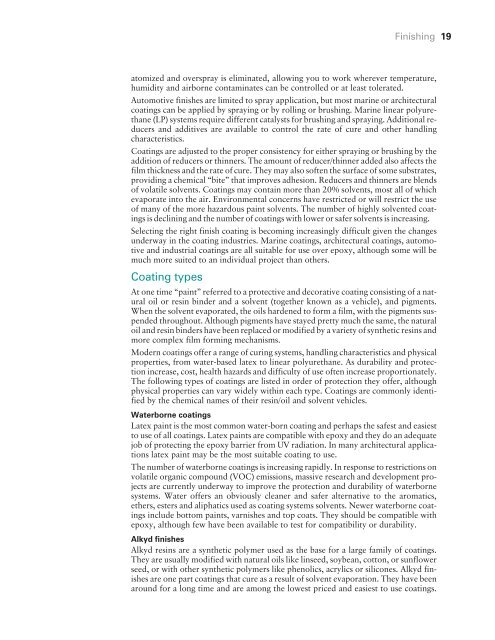Final Fairing & Finishing - WEST SYSTEM Epoxy
Final Fairing & Finishing - WEST SYSTEM Epoxy
Final Fairing & Finishing - WEST SYSTEM Epoxy
Create successful ePaper yourself
Turn your PDF publications into a flip-book with our unique Google optimized e-Paper software.
atomized and overspray is eliminated, allowing you to work wherever temperature,<br />
humidity and airborne contaminates can be controlled or at least tolerated.<br />
Automotive finishes are limited to spray application, but most marine or architectural<br />
coatings can be applied by spraying or by rolling or brushing. Marine linear polyurethane<br />
(LP) systems require different catalysts for brushing and spraying. Additional reducers<br />
and additives are available to control the rate of cure and other handling<br />
characteristics.<br />
Coatings are adjusted to the proper consistency for either spraying or brushing by the<br />
addition of reducers or thinners. The amount of reducer/thinner added also affects the<br />
film thickness and the rate of cure. They may also soften the surface of some substrates,<br />
providing a chemical “bite” that improves adhesion. Reducers and thinners are blends<br />
of volatile solvents. Coatings may contain more than 20% solvents, most all of which<br />
evaporate into the air. Environmental concerns have restricted or will restrict the use<br />
of many of the more hazardous paint solvents. The number of highly solvented coatings<br />
is declining and the number of coatings with lower or safer solvents is increasing.<br />
Selecting the right finish coating is becoming increasingly difficult given the changes<br />
underway in the coating industries. Marine coatings, architectural coatings, automotive<br />
and industrial coatings are all suitable for use over epoxy, although some will be<br />
much more suited to an individual project than others.<br />
Coating types<br />
<strong>Finishing</strong> 19<br />
At one time “paint” referred to a protective and decorative coating consisting of a natural<br />
oil or resin binder and a solvent (together known as a vehicle), and pigments.<br />
When the solvent evaporated, the oils hardened to form a film, with the pigments suspended<br />
throughout. Although pigments have stayed pretty much the same, the natural<br />
oil and resin binders have been replaced or modified by a variety of synthetic resins and<br />
more complex film forming mechanisms.<br />
Modern coatings offer a range of curing systems, handling characteristics and physical<br />
properties, from water-based latex to linear polyurethane. As durability and protection<br />
increase, cost, health hazards and difficulty of use often increase proportionately.<br />
The following types of coatings are listed in order of protection they offer, although<br />
physical properties can vary widely within each type. Coatings are commonly identified<br />
by the chemical names of their resin/oil and solvent vehicles.<br />
Waterborne coatings<br />
Latex paint is the most common water-born coating and perhaps the safest and easiest<br />
to use of all coatings. Latex paints are compatible with epoxy and they do an adequate<br />
job of protecting the epoxy barrier from UV radiation. In many architectural applications<br />
latex paint may be the most suitable coating to use.<br />
The number of waterborne coatings is increasing rapidly. In response to restrictions on<br />
volatile organic compound (VOC) emissions, massive research and development projects<br />
are currently underway to improve the protection and durability of waterborne<br />
systems. Water offers an obviously cleaner and safer alternative to the aromatics,<br />
ethers, esters and aliphatics used as coating systems solvents. Newer waterborne coatings<br />
include bottom paints, varnishes and top coats. They should be compatible with<br />
epoxy, although few have been available to test for compatibility or durability.<br />
Alkyd finishes<br />
Alkyd resins are a synthetic polymer used as the base for a large family of coatings.<br />
They are usually modified with natural oils like linseed, soybean, cotton, or sunflower<br />
seed, or with other synthetic polymers like phenolics, acrylics or silicones. Alkyd finishes<br />
are one part coatings that cure as a result of solvent evaporation. They have been<br />
around for a long time and are among the lowest priced and easiest to use coatings.
















